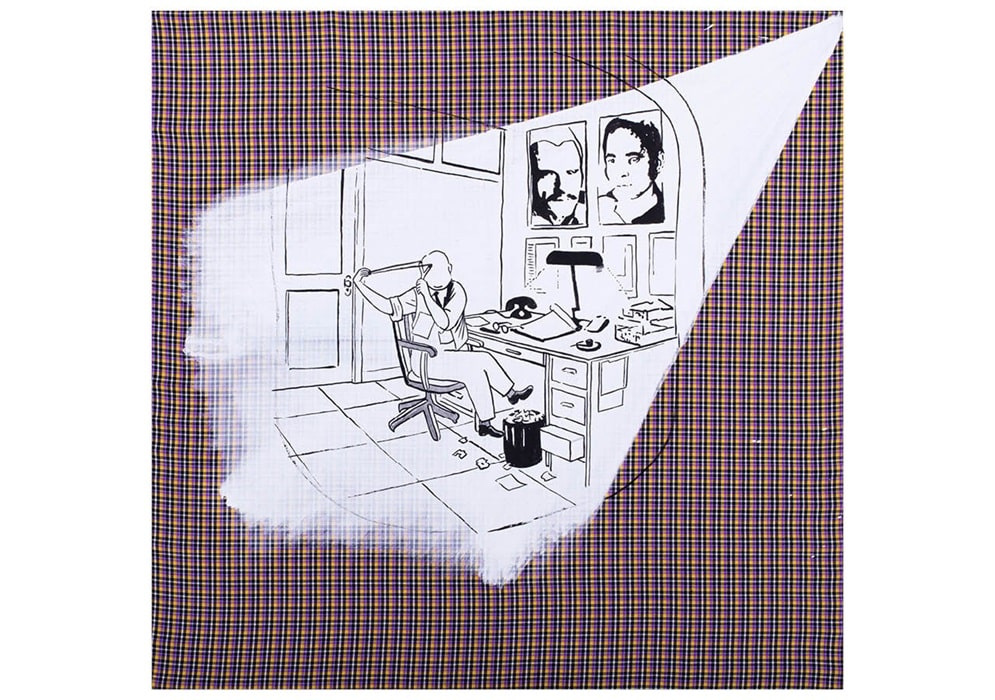From September 2024, the Schinkel Pavillon will be showing a large-scale exhibition by Sigmar Polke (1941-2010) with more than forty international loans in its historic rooms. Polke is considered one of the outstanding artists of the 20th century in Germany and beyond. As a pioneer for female artists of younger generations, the exhibition aims to make his artistic work accessible to a broad and young audience again, as Polke’s work has not been publicly recognized in Berlin for a long time.
Image above: Image: Sigmar Polke, Ohne Titel (Dr. Bonn), 1978, Groninger Museum, Groningen. Photo: Marten de Leeuw; © The Estate of Sigmar Polke, Cologne / VG Bild-Kunst, Bonn 2024
The exhibition brings together paintings, photographs, films and graphics from the 1960s to the 2000s and illustrates the artist’s artistic complexity, which is characterized by astute observations and weighty statements of irony and experimentation. The selected works also focus on the political aspects of Polke’s work, who was not only a precise analyst of his present, but also a critical commentator ahead of his time.
From an early age, Polke was interested in found images and their impact on the public, their circulation and legibility. At the beginning of his artistic career in 1963, while still an art student, Polke, together with Manfred Kuttner, Konrad Lueg and Gerhard Richter, proclaimed the artistic movement of Capitalist Realism, which became known as German Pop – a response to the art of the GDR at the time. The growing economy in West Germany and the accompanying bourgeois post-war idyll created new, consumerist imagery in advertising and magazines, which Polke playfully and far-sightedly incorporated into his works. He anchored his pictorial sources in the reality of the print media, even when he “alchemically” steered the painting process in new directions in order to look far beyond modernity to history (of the earth and of people).
Sigmar Polke, who was born in the Silesian town of Oels, now Oleśnica, was one of the artists of the 1960s who dealt with the collective trauma of the post-war generation. Polke confronted the political crisis of his time with a genuinely painterly, yet highly analytical approach to reality. In view of today’s increasing conflicts, crises and their representation in the media, the supposedly historical in Polke’s work proves to be highly topical even fourteen years after his death.
These are works that appear light and disguised as jokes and only reveal their critical nature at second glance. In Dr. Bonn, 1978, a civil servant with an obliterated face sits in front of his desk about to commit suicide with a slingshot. On the wall in front of him hang the striking mugshots of two RAF members. Sicherheitsverwahrung, 1979, captures the arrest of a woman in the style of a comic strip. Anyone approaching the picture carrier will recognize that it is adorned with fine gold chains, safety pins and trinkets.
The title of the exhibition Der heimische Waldboden is to be understood both figuratively and in real terms and refers ironically to the humus of the artist’s biography,= especially to post-war German society. Polke’s biography was shaped by the history of East and West Germany. The exhibition also explores his connection to Berlin and its history, which is particularly evident in the film documents. In addition to important paintings such as Carl Andre in Delft 1968, Die Schmiede, 1975, Gangster, 1988, Flüchtende, 1992 or the later pigment painting Lapislazuli, 1992, the exhibition also focuses on a collection of photographs from the 1960/70s that have never been exhibited before – the majority of which are unique. They reflect the energy of the youth movement of the time, which subsequently changed our society and our way of life. Created with the camera and in the darkroom, they remain as touching testimonies of a contemporary who exposed himself to the turmoil and moments of happiness with great sensitivity. Mental agility and artistic-material research are characteristic of Polke. His entire oeuvre bears witness to an inimitable personal and artistic love of freedom, without ever denying his belief in the great communicative power of art.
The exhibition will be on display at the Fondation Vincent van Gogh Arles from March 1 to October 19.
Team:
Curator: Bice Curiger
Artistic director: Nina Pohl
Project management: Lina Louisa Krämer
Curatorial collaboration: Klara Hülskamp (until Feb 2023), Dr. Luisa Seipp (until Dec 2023), Christina Maria Ruederer (from Jan 2024), Margaux Bonopera (Fondation Vincent van Gogh Arles, from July 2024)
Consultant: Michael Trier
Interns: Anaïs Nyfeller, Marie Hütter
WHEN?
Opening: September 11, 2024, 6 pm as part of the Berlin Art Week
Exhibition dates: Thursday, September 12, 2024 – Sunday, February 02, 2025
Opening hours: Thursday – Friday, 2 – 7 p.m., Saturday – Sunday, 11 a.m. – 7 p.m.
Terrace talk with Bice Curiger: September 11, 2024, 6.30 pm
WHERE?
Schinkel Pavilion
Oberwallstraße 32
10117 Berlin






